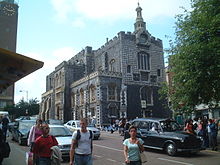- Norwich Guildhall
-
Norwich Guildhall (informally the Guildhall) is an historic listed building on Gaol Hill in the city of Norwich, United Kingdom. It was constructed between 1407 and 1413 and served as the seat of city government from the early 15th century until 1938, when it was replaced by the newly-built City Hall.[1] At the time of the building's construction and for much of its history Norwich was one of the largest and wealthiest cities in England, and today the Guildhall is the largest surviving medieval civic building in the country outside of London.[1]
The Guildhall currently serves as the offices of Norwich Heritage Economic and Regeneration Trust and also contains a Caley's Cocoa Café.[1] It is one of the 12 historic Norwich buildings in the Norwich 12 initiative, a project to develop an integrated group of heritage attractions in Norwich.[2][3]
Contents
History
The Guildhall was constructed to enable the greater self-governing powers conferred upon Norwich by the Charter of 1404 to be administered more efficiently. Prisoners first occupied the crypts of the building in 1412. Two timber and tile towers on the north and south sides of the building were destroyed when the roof of the Council Chamber collapsed in 1511. In 1534 a new Council Chamber was completed. As part of the works, the exterior wall of the eastern face of the new Chamber was faced with chequered flint work and freestone, and a central panel containing a fragment of the Arms of Henry VIII, flanked by the City Arms and the arms of the St George’s Company. Additions to the south side of the building were constructed in 1861 by Thomas Barry, the City Surveyor.
Civic affairs were conducted in the building until 1938, when the new City Hall was opened. Magistrates' Courts continued to be held in the old Common Council Chamber until 1977 and prisoners were held in the building until 1980.[4] Work to restore and strengthen the Guildhall clock tower began in July 2010.[5][6]
In June 2011, the Guildhalls Counsil Chamber and Sword Room was taken over by the sight specific theatre production, Monsters by Niklas Rådström, a play about the killing of James Bulger.
See also
References
- ^ a b c "The Guildhall". Norwich 12. http://www.norwich12.co.uk/the-guildhall/. Retrieved 28 September 2010.
- ^ "History by design". The Guardian. http://www.guardian.co.uk/enjoy-england/visit-norwich-history. Retrieved 28 September 2010.
- ^ "About us". Norwich 12. http://www.norwich12.co.uk/about-us/index.htm. Retrieved 28 September 2010.
- ^ "70: Norwich Guildhall". Eastern Daily Press. http://www.edp24.co.uk/content/edp24/norfolk-life/norfolk-history/content/70NorwichGuildhall.aspx. Retrieved 28 September 2010.
- ^ "Norwich Guildhall to be restored". Evening News. 10 June 2010. http://www.eveningnews24.co.uk/content/eveningnews24/norwich-news/story.aspx?brand=ENOnline&category=News&tBrand=ENOnline&tCategory=xNews&itemid=NOED09%20Jun%202010%2016%3A04%3A16%3A907. Retrieved 28 September 2010.
- ^ "Guildhall reconstruction work". Norwich City Council. http://www.norwich.gov.uk/site_files/pages/City_Council__Guildhall.html. Retrieved 28 September 2010.
External links
Categories:- Buildings and structures in Norwich
- Grade I listed buildings in Norfolk
Wikimedia Foundation. 2010.

